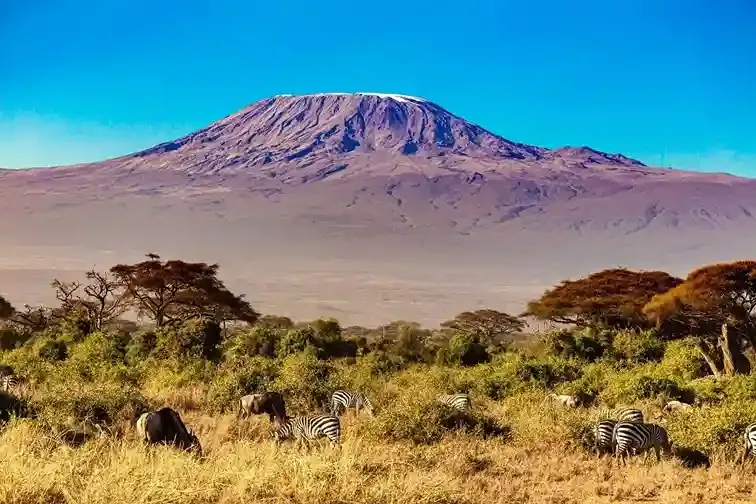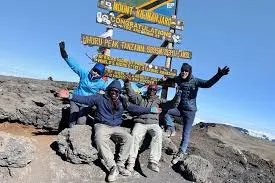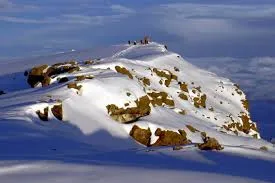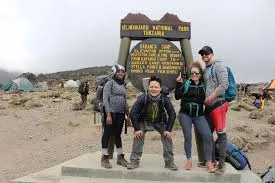Kilimanjaro’s Place in African Geography & Tourism
Mount Kilimanjaro, Africa’s highest peak, stands as a geographic marvel and a cornerstone of global tourism. Towering at 5,895 meters, it boasts diverse ecological zones, from lush rainforests to arctic summits, drawing over 50,000 adventurers annually. Its cultural significance to the Chagga people and economic impact on Tanzania make it a must-visit destination. With Capable Africa Tours, explore Kilimanjaro’s unique geography and embark on a transformative trekking experience.
Plan Your Kilimanjaro Trek Now
Kilimanjaro’s Geographic Significance
Mount Kilimanjaro, located in northeastern Tanzania near the Kenyan border, is a dormant stratovolcano and Africa’s tallest peak at 5,895 meters (19,341 feet). Its proximity to the equator, combined with its snow-capped summit, makes it a unique geographic landmark. Formed over a million years ago, Kilimanjaro comprises three volcanic cones—Kibo, Mawenzi, and Shira—with Kibo’s Uhuru Peak as the highest point. Its diverse ecological zones, spanning from cultivation to arctic conditions, support a rich biodiversity, making it a focal point for geographic and ecological studies.
Key Geographic Features
- Elevation: 5,895 m, the highest free-standing mountain in the world.
- Location: 3°S latitude, near Moshi, Tanzania, 300 km from the equator.
- Volcanic Structure: Comprises Kibo (active), Mawenzi, and Shira cones.
- Ecological Zones: Five distinct zones supporting varied flora and fauna.
- Glaciers: Furtwängler Glacier and Rebmann Glacier, shrinking but iconic.
Ecological Zones of Kilimanjaro
| Zone | Elevation (m) | Features | Flora & Fauna |
|---|---|---|---|
| Cultivation | 800–1,800 | Farmland, villages | Banana, coffee, Chagga settlements |
| Rainforest | 1,800–2,800 | Dense forest, high rainfall | Colobus monkeys, turacos, orchids |
| Heath/Moorland | 2,800–4,000 | Shrubland, open vistas | Giant groundsels, lobelias |
| Alpine Desert | 4,000–5,000 | Barren, rocky terrain | Sparse vegetation, lichens |
| Arctic Summit | 5,000–5,895 | Ice, snow, extreme cold | Minimal life, glaciers |
Kilimanjaro’s Role in African Tourism
Kilimanjaro is a cornerstone of African tourism, attracting over 50,000 climbers annually and generating significant revenue for Tanzania. The mountain contributes approximately $50 million to the economy through park fees, local employment, and tourism-related services. Capable Africa Tours enhances this impact by offering sustainable trekking packages, supporting local guides, porters, and communities while promoting eco-friendly practices.
Tourism Statistics
| Metric | Value |
|---|---|
| Annual Visitors | 50,000+ |
| Economic Contribution | $50 million/year |
| Jobs Supported | 10,000+ (guides, porters, hospitality) |
| Popular Routes | Marangu, Machame, Lemosho, Rongai |
| Summit Success Rate | 65–90% (route-dependent) |
Why Kilimanjaro Attracts Tourists
- Adventure Appeal: Offers a challenging yet achievable climb, no technical skills required.
- Scenic Diversity: Five ecological zones provide a unique trekking experience.
- Cultural Connection: Interaction with Chagga communities and local culture.
- Global Recognition: One of the Seven Summits, drawing international adventurers.
- Accessibility: Well-regulated routes with Capable Africa Tours’ expert guidance.
Experience Kilimanjaro’s Majesty
Watch this video to discover why Mount Kilimanjaro is a global tourism icon with Capable Africa Tours, showcasing its stunning landscapes, vibrant ecosystems, and cultural heritage.
Cultural Significance of Kilimanjaro
Kilimanjaro holds deep cultural importance for the Chagga people, who view it as a sacred mountain. Their folklore describes it as a dwelling place of spirits, and traditional practices, such as offerings at its base, persist. Capable Africa Tours integrates cultural experiences into treks, offering visits to Chagga villages and insights into their agricultural lifestyle, centered around banana and coffee farming.
Cultural Highlights
- Chagga Heritage: Learn about their history, from cave dwellings to modern villages.
- Local Markets: Visit Moshi markets for authentic crafts and cuisine.
- Storytelling: Guides share Chagga myths about Kilimanjaro’s spiritual role.
- Sustainable Tourism: Capable Africa Tours supports local artisans and farmers.
Popular Kilimanjaro Trekking Routes
Kilimanjaro offers seven main routes, each with unique features. Capable Africa Tours tailors packages to suit various fitness levels and preferences, ensuring a safe and memorable climb.
Route Comparison
| Route | Duration | Distance | Success Rate | Features |
|---|---|---|---|---|
| Marangu | 5–6 days | 64 km | 65–70% | Hut-based, beginner-friendly |
| Machame | 6–7 days | 62 km | 80–85% | Scenic, challenging, camping |
| Lemosho | 7–8 days | 70 km | 85–90% | Scenic, less crowded, gradual ascent |
| Rongai | 6–7 days | 73 km | 80–85% | Remote, northern approach, camping |
Preparing for Your Kilimanjaro Trek
Climbing Kilimanjaro requires physical, mental, and logistical preparation. Capable Africa Tours provides comprehensive guidance to ensure you’re ready for the adventure.
Preparation Tips
- Physical Training: Build endurance with 4–5 weekly cardio sessions (45–60 min).
- Strength Exercises: Focus on squats, lunges, and core workouts for steep terrain.
- Gear Checklist: Waterproof boots, layered clothing, 30–40L daypack, -15°C sleeping bag.
- Altitude Prep: Practice hikes above 2,500 m or use altitude simulation gear.
- Health Precautions: Consult a doctor for vaccinations and altitude medication.
Gear Rental with Capable Africa Tours
Capable Africa Tours offers rentals for essential gear like sleeping bags, trekking poles, and down jackets, ensuring quality and convenience without excess baggage.
Environmental and Conservation Efforts
Kilimanjaro’s ecosystems face threats from climate change and tourism. Capable Africa Tours partners with local organizations to promote sustainable practices, including waste management and reforestation projects.
Conservation Initiatives
- Waste Management: Porters remove all litter from routes.
- Reforestation: Support planting native trees in lower zones.
- Eco-Friendly Camps: Use biodegradable products and solar chargers.
- Community Support: Fund schools and clinics in Chagga villages.
Ready to Explore Kilimanjaro with Capable Africa Tours?
Embark on a life-changing journey with Capable Africa Tours. Our expert guides, sustainable practices, and tailored packages ensure a safe, scenic climb to Kilimanjaro’s summit. Book now to experience Africa’s iconic peak!
- High summit success rates (up to 90% on Lemosho)
- Eco-conscious treks supporting local communities
- All-inclusive packages with meals and transfers
- Gear rentals for hassle-free preparation
- Customizable itineraries for all levels
Limited spots for Kilimanjaro treks — book now to conquer Africa’s highest peak!
Plan Your Trek Now


